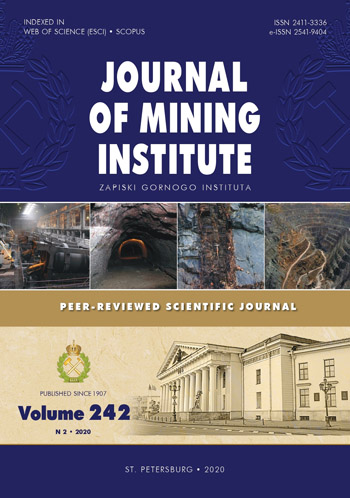Effective capacity building by empowerment teaching in the field of occupational safety and health management in mining
- 1 — Ph.D., Dr.Sci. President Technische Hochschule Georg Agricola University ▪ Scopus
- 2 — International lecturer Technische Hochschule Georg Agricola University
- 3 — Ph.D. Vice-Head Hanoi University of Mining and Geology
- 4 — Ph.D., Dr.Sci. Head of Department Saint Petersburg Mining University ▪ Orcid ▪ Elibrary ▪ Scopus ▪ ResearcherID
Abstract
The paper is dealing with a developed concept named Empowerment Teaching, which is based on practical teaching experience gained in various mining universities. It is demonstrated that this concept can be used to increase the effectiveness of knowledge transfer to mining countries in the world, as well as to overcome cultural barriers between lecturers and their students. The two models of participatory training, which are proposed to be named “physical” and “emotional” models, are portrayed. The authors are convinced that participatory training methods can be an ideal answer to a challenge associated with workers’ competencies in mining, namely – the potential of highly motivated and well-educated young academics is often diminished by a lack of ability to apply their knowledge. A special emphasis is made on the possible application of empowerment teaching for educational and training activities in the field of occupational safety and health (OSH), which is a matter of utmost importance for the mining industry. Several benchmarking initiatives in the field of OSH (“safety culture”, zero-accident vision) are underlined to be encouraged and promoted by means of new teaching methods. The examples of successful international cooperation among universities are given, as well.
References
- Kazanin O.I., Drebenstedt C. Mining Education in the 21st Century: Global Challenges and Prospects. Zapiski Gornogo instituta. 2017. Vol. 225, p. 369-375. DOI: 10.18454/PMI.2017.3.369 (in Russian).
- International Labour organization. Guidelines on occupational safety and health management systems, ILO-OSH 2001. URL: www.ilo.org/safework/info/standards-and-instruments/WCMS_107727/lang--en/index.htm (date of access 02.06.19).
- Kazanin O.I., Korshunov G.I., Rudakov M.L. The implementation of modern occupational safety and health system as an element of sustainable development of coal mining enterprises. Innovation-Based Development of the Mineral Resources Sector: Challenges and Prospects: Proceedings of the 11th Russian-German Raw Materials Conference. November 7-8, 2018. Potsdam, Germany, p. 571-578.
- Kretschmann J., Nguyen N. Successful implementation of the German risk management system in occupational safety and health to South East Asia – cultural conditions and challenges. Proceedings of the 2-nd international conference on advances in mining and tunneling. Hanoi. Vietnam. August 2012, p. 202-206.
- Kretschmann J., Laurence D., Nguyen N. Support from the Society of Mining Professors for enhancement of knowledge transfer in Southeast Asia. 28th SOMP Annual Meeting and Conference, Torino, Italy, 3-6 July 2017, p. 37.
- Mainstreaming occupational safety and health into university education. European Agency for Safety and Health at Work, 2010. URL: osha.europa.eu/en/tools-and-publications/publications/reports/mainstream_osh_university_education (дата обращения 02.06.19).
- Nguyen N. Participatory training methods can be applied in safety training courses in the Vietnamese coal mining industry. Mining Industry Journal. 2011. Vol. 6, p. 39-40.
- OHSAS 18001:2007. Occupational health and safety management systems – Requirements. URL: www.bsigroup.com/ en-GB/ohsas-18001-occupational-health-and-safety/ (date of access 02.06.19).
- Participatory Training: A book of readings. Society for Participatory Research in Asia (PRIA). New Delhi, India, 2002, p. 100.
- Review of successful Occupational Safety and Health benchmarking initiatives, European Agency for Safety and Health at Work, 2015. URL: osha.europa.eu/en/tools-and-publications/publications/report-eu-osha-review-successful-occupational-safety-and-health/ view (date of access 02.06.19).
- Salminen S., Palukka P. Occupational safety training in the Finnish education System. Journal of Occupational Health and Safety. 2007. Vol. 23 (4), p. 383-389.
- The Incheon Declaration and the Education 2030 Framework for Action (2015). URL: https://unesdoc.unesco.org/ark:/ 48223/ pf0000245656 (date of access 02.06.19).
- Zwetsloot G., Aaltonen M., Wybo J.L., Saari J., Kines P., Op De Beeck R. The case for research into the zero accident vision. Safety Science. 2013. Vol. 58, p. 41-48.
- Work Improvements in Small Enterprises (WISE) – Package for trainers. ILO. 2004. URL: www.ilo.org/ safework/info/instr/WCMS_110322/lang--en/index.htm (date of access 02.06.19).
